Autopolis, Japan
All Japan Road Race Series
Kawasaki Media Tour
May 28, 2007
Words and Picture by Sam Quarelli Fleming
As part of the good will junket of Japan by Kawasaki the collective American journalist contingency was treated to two days at Kawasaki’s magnificent race track: Autopolis. The first day was a during the fourth of the seven round Japanese national race series. The second was a track day for interested journalists.
Diligent readers of this paper were introduced to Autopolis in your correspondent’s review of the ZX-10 in December 2005. The geographic grandeur, utopian architecture and evocative macadam make Autopolis one of my three favorite race tracks in the world (the other two being Mugello in Italy’s Tuscany and Phillip Island in Australia’s Phillip Island). Autopolis is the legacy of hubris and exuberance of the Japanese economic bubble of the early 1990s. The construction of Autopolis is rumoured to have cost upwards of $300 million but the track and four star hotel on its premise never opened as the construction was completed just as the world’s investor did a collective “WTF?” at the valuations of Japanese stocks and real estate (at the time a single sky scraper in Tokyo was valued more than the entire stock exchange in Australia).
The tumbling asset prices (both securitized and un-securitized) created economic hardships from which the Japanese economy has yet to recover. Assuming 7% loans with a twenty year term the original owners would have been looking at payments of about $2,335,896…per month. That’s, roughly,$77,530 per day. Unable to find the 1,000 track day riders PER DAY that they would need to meet those notes the track went into default.
The track was largely abandoned for the next fifteen years. Kawasaki ended up buying it for a song (rumors say $10,000,000, they’d only need about 30 track day enthusiasts per day to pay that note) tore down the vacant hotel, painted the corner stations and started using it for testing and races.
My previous visit had been to a ghostly empty venue that seemed more like a study in neutron bomb after effects rather than the heady humanistic cocktail of adrenalin, fear and exhilaration that courses through the pits of an active track. Eighteen months later I am back on the rim of an extinct volcano surveying the vibrant pits filled with racers, families and enthusiast. Steeling myself against an insurmountable language barrier and armed with a VIP pass and my camera (finally) I delved into event.

Autopolis, (translate into greek?) before the hotel was razed
in November 2005.
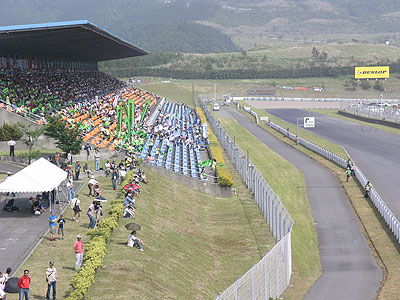
Autopolis sans hotel with a portion of the day’s 20,000 spectators. As real
income has dropped in Japan the attendance by both racers and fans has
been slowly dropping at the motorbike races.

The AJRR series is the only national roadrace series in Japan. The classes
are all actively contested and are as such: Superbike 1000s, ST-600s,
GP 250, GP 125 and GP Mono. The 1000s are allowed reasonably
comprehensive modifications including cams, transmission, headwork,
exhausts, suspension, frame bracing, replacing the brakes, swingarm,
wheels, suspension and ECU. The 600s are basically superstock machines
with optional ECUs, suspension and exhausts. Bigger teams get to use the
garages, smaller teams are in the next lane back. Many teams were racing
out of crowded van without so much as a three-rail trailers. The transporters
are small but the riders are fast.

Daigo Fukuoka (the last name is also the name of a city in Japan) in his
Elf hat poses with a competitor and his 250cc 4-stroke GP bike. I am sure
if I spoke Japanese I could have heard him espouse on the virtues of racing
pure bred GP machinery which are easy to work on and how the GP riders
all stick together in the pits. These bikes use custom frames housing modified
versions of the 250cc four stroke single engines the big four produce for
dirtbikes. As a GP class the modifications seem to be pretty unrestricted
beyond four stroke single and displacement. These bikes are available
in a ready to race format from a variety of suppliers for about $10,000.

Top view of Fukuoka’s Kawasaki GP-mono bike with the carburetor removed
for a re-jet. Dirt bike technology means old fashioned coil ignition (boo-hiss)
but with huge sparred frame and lightweight. This one is powered by a
KX-250F motor fitted to a MARS original frame. I believe the whole package
is available from Miyawaki. It puts out about 39ps and has a top speed of
around 180 kph.or about 115 mph. These look like they would be very
fun to ride.
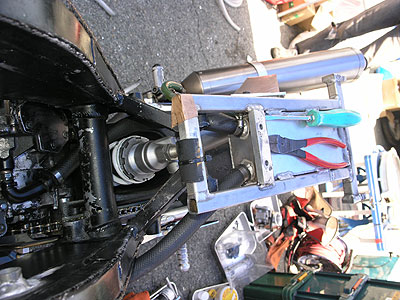
I am not sure if even a heavy breathing single needs a breather box quite
as large as this one but perhaps without an airbox it’s a good idea.

With a weight of only about 80 kg (176 lbs) a single four piston Brembo
is fitted to the front of most GP-Mono bikes.

The GP-Mono bikes are fitted with massive flat slide carbs.
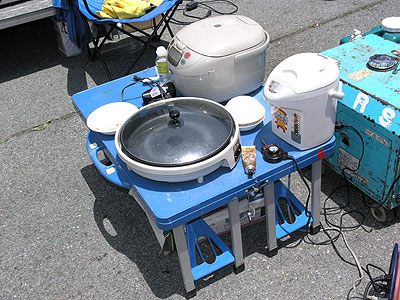
The typical racer cookout in Japan features (from the back) a ricer maker,
a tea maker and an electric skillet.
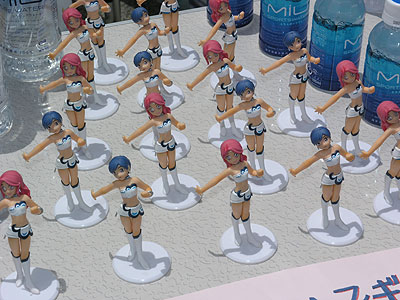
I have no idea what the deal is with these little dolls but many of the
big teams were giving away little umbrella girl figurines in the pits.

This is pretty existentialist if you stop to think about it. Even winning
multiple championships and winning the love of his high school sweetheart
will not end his challenge. There will be no contentment in this young
man’s life until the grave. I salute you number 56.

This group, as far as I could tell, are in their early thirties and all rode their
motorcycles to the track for the races. At least one of the women was riding
her own streetbike. One of them is a journalist, another is a mechanic for
automatic sushi machines, another works for the municipal government
and another works in a record store. They were mainly riding naked 1000s.
The entire exchange of information was conducted mainly through sign
language and smiling so really whatever you make up could be just as
accurate as what I wrote down.

Trick Star is a top ten 600 team. They ran two bikes in the race.
This is their truck.

One of Trick Star’s 600s on the grid for the 600 race. In a tribute to
efficiency Japanese racers can purchase “White Body Machines”. This
allows them to buy a bike straight from the factory floor without any
of the street equipment which would be summarily tossed during the
race preparation. The “White Body” bikes come with no lights, no
registration and no exhaust pipe. Kawasaki sells about ten to fifteen
ZX-10s and about thirty ZX-6s each year in this state. This saves racers
a bit of money on the up front costs as well as bypassing the regulations
governing the sale of powerful motorcycles in Japan.
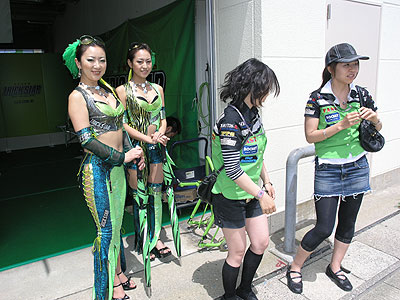
The women of Trick Star. Two are full-time, two are temps.
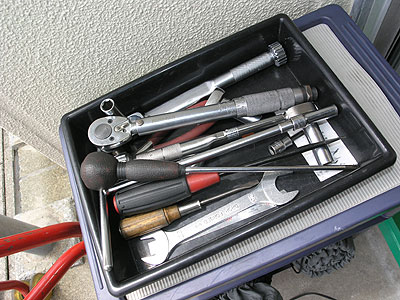
Tools are universal.
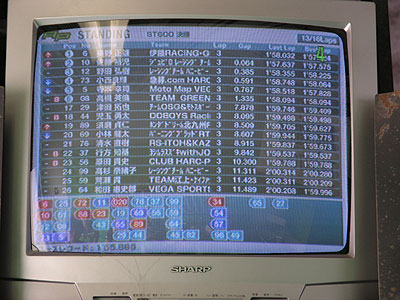
Every garage in Autopolis has a TV with the current running order and
scoring information. The top six positions are fixed while the rest of the
display scrolls through the results. On lap 13 of 16 a Yamaha runs in first
(there is no way to know that from this display) while the top Kawasaki
runs in 6th. Naoko (number 99) runs in 24.

A Trick Star mechanic relays timing and scoring to his rider.
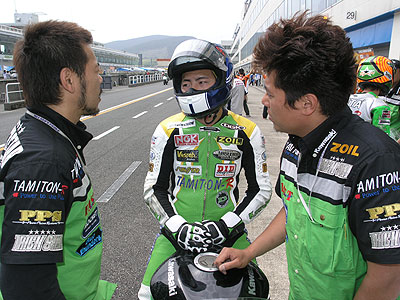
Post race debrief.

After each race the pits were opened up spectator to talk through
and take pictures of the riders, the bikes and the models.
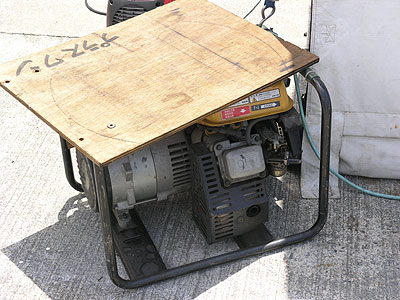
This is the generator for one of the big teams. I’ve seen guys show up
to track days in the US with more gear than some of these top Japanese
Superbike teams had. That said, Japan is a nation of about 150 million
people (roughly half the size of the US for those of you who have not
been paying attention) so the fastest racers in Japan are very fast.
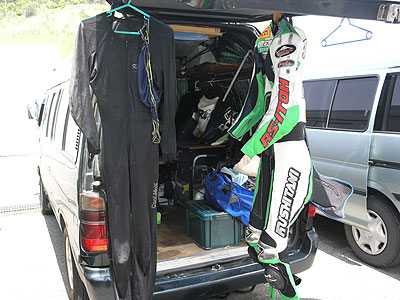
Racer’s van for a top rider.
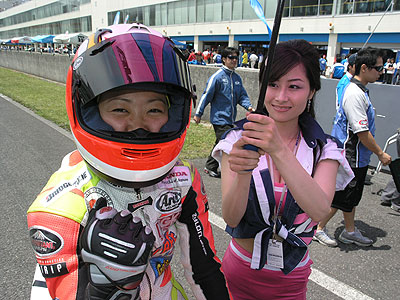
This is Naoko Takasugi. She is thirty years old and, although she has been
racing for ten years, she has only been riding 600s for four. Her 600cc
bike will remain a mystery because its manufacture did not drop $10,000
for my trip. She, however, is a total bad ass. She weighs 88lbs and stands
about five feet tall. She qualified in the middle of the grid out of 40 entries
and was turning consistent 2:00 lap times. For comparison the fastest lap
in the race was a 1:57, the fastest any of the US racer/journalists went the
next day (granted on stock bikes with only so-so tires) was in the 2:06 range.
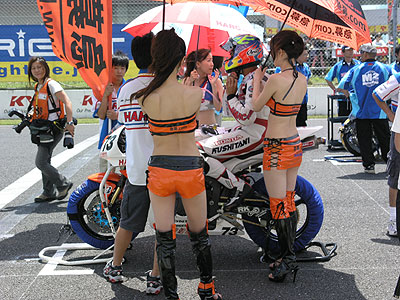
Japan’s state religion was Shinto until 1945. This is a combination of
state/emperor worship combined with the appreciation of gods’ work in
natural beauty or process. The Emperor of Japan is a direct descendant of
the religious leader who settled Japan with his followers from the mainland
and, until a formal renouncement of status in 1946, the emperor claimed
to be a living god. This ancient religious practice influences Japanese
traditions of culture, art, architecture and community. Besides selfless
obedience to the state/emperor a central tenet of Shinto is the reverence
and love for natural artifacts. At Autopolis this philosophy manifests in
appreciation of some fine Japanese ass in black vinyl high heels.

Nassert-Beet is a Japanese manufacturer of what appears to be some very
tasty exhaust pipes and rear-sets. Although they mainly focuses their racing
efforts on the eight-hours of Suzuka they are running a few of the superbike
rounds on their ZX-10.

The Beet bike with a race KYB shock, some sort of trick linkage, folding
shift lever (endurance legacy), quick shifter, engine breather box (in
front of shock) but a conspicuously stock swingarm and pivot placement.

Beet racing gridded for the superbike race.

32 year-old Koji Nazaki expresses self-incrimination over the scuffed fairing
of his ZX-10 superbike. Koji works as a test rider for Kawasaki based out
of the testing department located in Building 38 of the Akashi works.
His co-workers help with the team hence the name “Team 38”. His bike
puts out 186ps, tops out at about 290 kph and weight 187 kgs (dig
the magnesium rims). His best finish to date is a 16th.

I don’t know who built it or what handling problem it was installed to
cure (grip? bump steer?) but this is a back of the grid superbike with
a custom swingarm.

You have to really want to lower your swingarm pivot to hand build
offsets and run an undersized pivot axle.
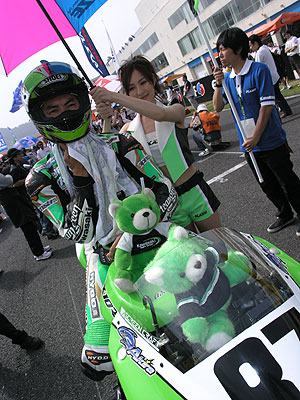
Akira Yanagawa qualified 2nd and finished 2nd after
leading the race for about half distance and a long dual
with two Suzukis.

Typically endurance racers are the most mechanically paranoid and
pessimistic. Apparently Akira’s mechanic used to endurance race since
he brought a spare shock and ECU out to the pre-grid.

Akira’s view of the start of the superbike race.
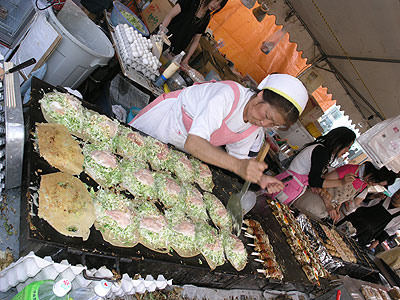
The Japanese take food very seriously. Being at the racetrack is no
excuse to slum in the cooking and eating departments.

Akira leads on lap three.

Valentino fan.

Running in fourth this rider made a desperate two position pass up the
inside into turn one. From 200 yards away it was clear he was not going
to make it stick. He tagged the rear wheel of one of the leading bikes
and cart wheeled into the gravel trap.
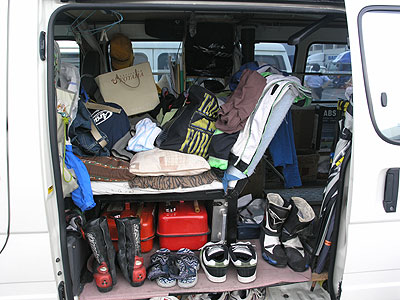
Even the bike goes in the van to the track. The fold down rear seat /
bed should be immediately adopted by Ford.

On the Monday following the races our press flack handlers had arranged
for a track day at Autopolis. Apparently this lead to some complicated
cultural negotiations since a ‘track day’ in Japan means hanging out at
the track with your friends drinking beer and smoking cigarettes. A track
day in the US means riding pretty motorcycles around in circles.
Fortunately everyone was able to get the semantics worked out and
we had two ZX-6s, a detuned ZX-10 and a ZX-14 between a dozen
or so of us for the day.
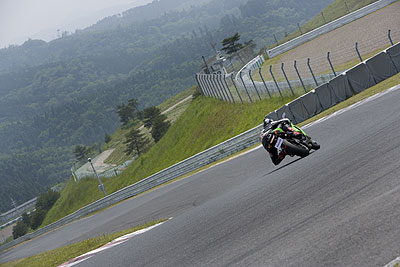
All alone at Autopolis; I don’t even want to know what this lap is costing.

A turret house at Kumamoto castle. It is a stretch to
include a picture of Kumamoto castle in this story
because it 90 minutes from the track and has nothing
to do with Kawasaki or racing but since it is unlikely
that I will ever have the opportunity to use this picture
at a later date, here it is. Consider it a Shinto appreciation
of natural beauty and state power.
